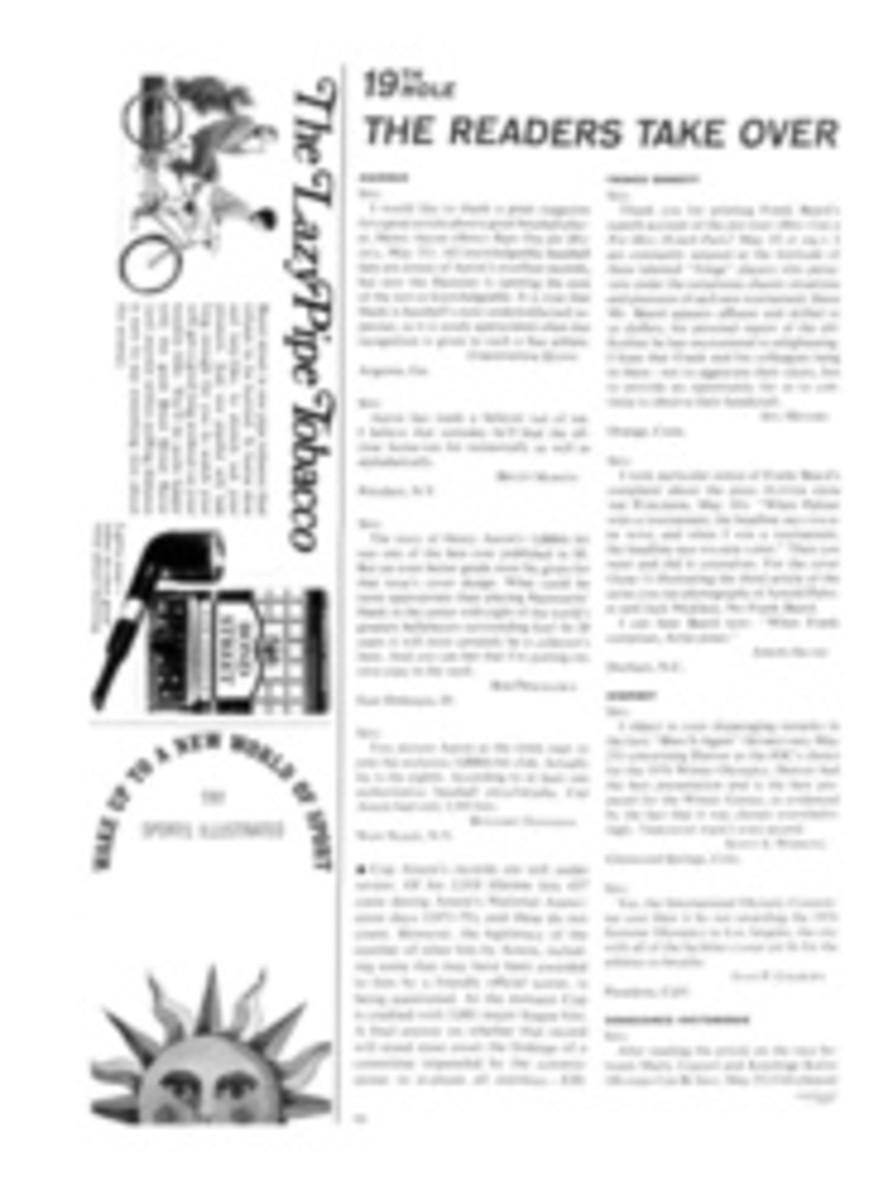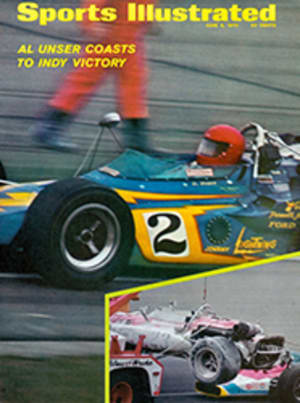
500 Miles Without a Pit Stop
Most records are doomed to be broken sooner or later, even Ruth's 714 home runs, DiMag's 56-game hitting streak and Bob Beamon's soaring broadjump through the rarefied Mexican air. One record that seems more than likely to outlive all the rest, however, belongs to a car that completed the 500 miles at Indianapolis without a single pit stop.
The record books for 1931 confirm this feat, which was accomplished first and foremost because the car was powered by a diesel engine—the first oil-burner ever at the old brickyard. Clessie Cummins, the man who owned and built it, had a kind of fixation on diesels. He had no thought of winning at Indy. When he entered his big white monster in the 500 he knew that the gas burners were faster than his No. 8, but Cummins wanted to capture the attention of the public, to make the nation aware that the oil-burning diesel engine belonged in automobiles.
Clessie's dream was to see this first Indy diesel do something that no one believed possible. "I don't claim to have the fastest car in the race," Clessie told reporters, "but I do have the sturdiest, most reliable engine. And we'll prove it by making the distance without stopping."
Diesel engines were not uncommon at that period. Cummins had been making them for a long time—for yachts. In the 1920s he operated a small factory in Columbus, Ind. but the Wall Street crash in 1929 wiped away his market, so in a desperate attempt to save his business he bought a secondhand Packard for $600 and tried his hand at diesel-powering an auto. He drove the car from Indiana to the 1930 Automobile Show in New York, completing the 800-mile trip at a fuel cost of $1.38. Despite its economy, however, the oil-burning engine was still considered too heavy and slow for automotive use.
Two months later Cummins took his car to Daytona Beach, Fla. and set a world speed record for diesel-powered vehicles of 80.398 mph. He returned to his factory and placed another diesel in a Model A Duesenberg. The new car boosted the speed record still higher to 100.75 mph in 1931, and Clessie Cummins began to think about entering a diesel at Indy.
The car was fast enough—minimum qualifying speed was just 70 mph—but there were several obstacles to its entry in the race. For one thing, official regulations specified gasoline-powered cars only; for another, the size of the engine and weight of the Cummins' car exceeded the maximum standards. Cummins went to Eddie Rickenbacker, a close and influential friend, who convinced the powers to accept his diesel as a special engineering entry.
There were other difficulties. Dave Evans, the driver Cummins hired, had never seen a diesel engine before he arrived at the Columbus factory three months before race day. But the 28-year-old Texan had had plenty of experience in other cars and figured he could cut it in this one. After working as a Hollywood stuntman in some of the Hell's Angels-type movies of the period he bought a Duesenberg for $14,000 and raced it at Indy for the first time in 1927. Evans had never won at the Speedway, but he was an excellent driver who also possessed great stamina. In short, he was just the man to drive around the track nonstop.
Cummins selected Thane Houser as the car's riding mechanic. Houser had ridden with many of the finest drivers in the U. S.
First at the factory and later at the track itself, Evans and Houser overhauled the steering, adjusted the springs and placed double shock absorbers on the wheels. They made the cockpit as comfortable as possible and installed a special clutch and brake pedal to keep Evans from having to shift his feet.
To get himself in shape for the ordeal, Evans "laid off booze and women and ate good and took a lot of exercise," according to his own evidence. He took to the road on foot in daily workouts to get his legs in shape and strengthened his hands by playing a lot of golf.
A few days before the race Jimmy Doolittle, another legendary figure of American aviation, called Cummins to say that he was excited by the car and to ask to become a member of the pit crew. Jimmy was given the job of signalman—he was to communicate with Houser during the race by means of coded words on a blackboard. On the morning of the race the signalman and the riding mechanic worked out the code, and Doolittle placed it behind the belt of his jacket for safekeeping.
Cummins had been criticized by some for disclosing his plan to run nonstop in advance of the race. Almost everyone believed the result could only be disappointment. But as Cummins wrote later, "I knew that the standard fuel tank allowed for the Indianapolis cars held sufficient fuel to take us the distance, and it didn't seem unreasonable to me that we could make it."
The day of the race wasn't the sort officials at the brickyard dream about. Storm clouds swept over the 2½-mile track, and thousands of racing fans looked for shelter from the rain. It wasn't until two hours past starting time that the clouds finally disappeared and Rickenbacker, who also served as the Speedway's general manager and race director, took the megaphone to order: "Gentlemen, start your engines." Photographers moved away from the cars, and the top drivers of 1931—Billy Arnold, Louis Schneider, Tony Gullota, Wild Bill Cummings, Fred Frame and 35 others—climbed into their cockpits. Cummins' diesel started along with the rest. Perhaps because the track was still dangerously slippery from the rain, driver Evans, after giving his wallet and watch to Cummins, said, "Whatever you do, don't let them cremate me."
The race got under way with No. 8 running smoothly. The pit crew relaxed as they watched Evans and Houser sail by again and again without difficulty. As the race wore on, cars began to drop out. After the first 100 miles Houser began signaling to his pit crew. Cummins asked Doolittle what the signals meant. "I don't know, Cless," he said. "I can't find my code list." Doolittle rummaged through his pockets, and the rest of the pit crew began to search for the code. Every time the car passed the pit Houser signaled again, but the code couldn't be found and the pit crew, with question marks on their brows, held up oil cans, fuel containers and tires. Houser just shook his head in mounting frustration and drove on.
Cummins, Doolittle and the rest of his crew saw that the car's engine continued to run perfectly. They eventually decided that Houser's waving was probably only a joke the mechanic was playing on them. So the crew put down the tires and other equipment and, instead, held up soft-drink bottles and blew kisses at the car as it passed by.
Near the finish of the race the lead car, driven by Billy Arnold, the defending champion, lost a wheel, collided with another and caught fire. Louis Schneider's Miller got the checkered flag and a few minutes later No. 8 was 13th across the finish line.
Newspapermen rushed to the strange white whale and its driver. "You'd have thought I'd have come out of the sky," Evans said. "They were amazed. Cummins was speechless for a long time after the race. That nonstop dream of his was true. The diesel engine was made that day."
Only then did Jimmy Doolittle locate the list of coded signals he had slipped behind the belt of his uniform jacket. Studying it, he realized that what Evans and Houser had been trying to tell him was that a water-temperature gauge had been jarred loose and that they had no way to check the engine. Fearing they might overheat, they wanted a pit stop to make repairs.
Twelve years later, after Doolittle led the first U.S. bombing raid over Tokyo, Cummins sent him a wire. It read, "Mighty glad you didn't forget where you had put your charts."

